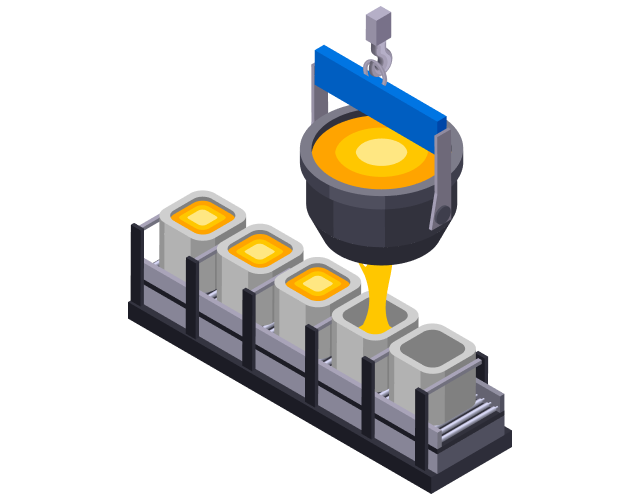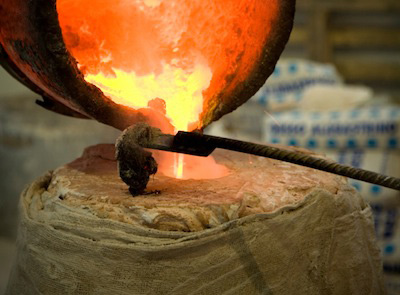A Deep Dive Into the Various Sorts Of Metal Casting and Their Utilizes
Metal Casting incorporates numerous strategies, each customized for specific applications and demands. From the economical sand spreading approach to the accuracy of investment spreading, each procedure has unique advantages. Die casting stands apart in high-volume production scenarios, while shed foam spreading introduces ingenious design possibilities. Furthermore, long-term mold casting is acknowledged for its durability. Understanding these approaches opens up a window right into their functional uses and ramifications in various markets. What exists beneath the surface of these casting techniques?
Sand Casting: A Flexible and Cost-Effective Method
Different casting methods exist, sand casting stays one of the most cost-effective and functional strategies in the metalworking sector. This method employs a blend of sand and a binding agent to develop molds, permitting the manufacturing of components in diverse shapes and sizes. Sand spreading is especially helpful for little to medium production runs, as it requires minimal upfront investment in tooling contrasted to other spreading techniques.
The process begins with the production of a mold and mildew, where liquified steel is poured in to form the preferred object once cooled. Its versatility makes it possible for using various metals, consisting of light weight aluminum, iron, and steel. On top of that, sand spreading can fit complicated geometries, making it appropriate for an array of applications, from vehicle elements to elaborate creative pieces. Generally, sand spreading's effectiveness and adaptability strengthen its value in the production landscape.
Financial Investment Casting: Precision and Information for Complicated Forms
Financial investment casting stands apart as an approach renowned for its ability to generate extremely detailed and detailed components. This process includes producing a wax pattern that is covered with a ceramic covering, which is after that warmed to remove the wax and harden the shell. The outcome is an exact mold that can catch intricate geometrical forms with amazing precision.
This casting technique is particularly helpful for creating parts with slim wall surfaces, fine attributes, and tight tolerances, making it optimal for industries such as aerospace, auto, and medical devices. Financial investment casting suits a variety of steels, consisting of stainless-steel, aluminum, and titanium, enabling makers to meet particular product demands.
The process decreases machining needs post-casting, which can boost efficiency and lower manufacturing prices. Generally, investment spreading is a preferred choice for applications where accuracy and detail are vital.
Die Casting: High-Volume Production With Excellent Surface Area End Up

Pass away casting is a highly efficient production procedure that stands out in generating huge quantities of steel components with extraordinary surface area finishes. This approach entails requiring molten metal into a mold and mildew dental caries under high stress, permitting quick production cycles and uniformity in the completed items. Generally used materials consist of light weight aluminum, magnesium, and zinc, which offer exceptional mechanical residential properties and corrosion resistance.
Pass away casting is especially advantageous for markets such as auto, electronic devices, and durable goods, where accuracy and top quality are critical. The procedure enables intricate designs, minimizing the requirement for added machining and completing procedures. Furthermore, the smooth surface areas created via die casting usually need very little post-processing, leading to reduced total production expenses. As a high-volume production method, die casting is perfect for makers seeking effectiveness without compromising on high quality, making it a recommended choice for countless applications throughout various fields.
Lost Foam Spreading: Cutting-edge Approach for Intricate Layouts
Lost foam spreading transforms the manufacturing of intricate steel parts by utilizing a distinct process that gets rid of the requirement for traditional molds. Instead of traditional mold-making, this method utilizes a foam pattern that is covered with a refractory material. When the pattern is established, molten metal is poured straight right into the mold, creating the foam to leave and evaporate behind an exact learn this here now cavity for the steel to load. This ingenious strategy permits for complex styles and detailed features that might be testing to accomplish with other casting methods.
In addition, lost foam spreading can decrease waste and energy usage, making it an eco-friendly alternative. Industries such as aerospace and automotive advantage greatly from this method, as it sustains the production of lightweight components with intricate geometries. Generally, shed foam casting stands out for its capacity to provide high-quality, customized metal components successfully.
Irreversible Mold Spreading: Resilience and Consistency in Steel Parts
Irreversible mold spreading is an extremely reliable technique for generating resilient and regular steel parts, leveraging multiple-use mold and mildews that are typically made from metals such as iron or steel. This spreading procedure includes pouring liquified steel into these mold and mildews, which are preheated to improve product top quality and reduce defects. Using recyclable mold and mildews not only minimizes waste yet also permits greater manufacturing prices, making it economically advantageous for producers.
The resulting parts exhibit excellent dimensional accuracy and surface coating, making them optimal for applications in auto, aerospace, and commercial machinery. Furthermore, irreversible mold casting can fit a range of alloys, better expanding its adaptability. The durability of the actors components is boosted due to the controlled cooling prices that advertise better grain structures. On the whole, this casting method sticks out for its ability to generate high-grade steel parts that meet rigorous efficiency requirements, guaranteeing reliability popular atmospheres.
Regularly Asked Concerns
What Materials Can Be Made Use Of in Various Metal Casting Procedures?

Numerous materials can be made use of in Metal Casting procedures, consisting of light weight aluminum, zinc, iron, and bronze. Each material uses one-of-a-kind buildings, influencing the spreading method's performance, stamina, and suitability for different applications in production.
How Do Casting Methods Influence the Mechanical Properties of Metals?
Casting methods significantly influence the mechanical residential properties of metals, influencing variables like hardness, ductility, and stamina. Variations in cooling prices and mold products can cause various microstructures, eventually influencing the performance of the final product.
What Are the Environmental Impacts of Metal Casting Procedures?
Metal Casting procedures can lead to air and water contamination, resource exhaustion, and substantial energy usage (Aluminum Foundry). Furthermore, the generation of waste materials and greenhouse gas discharges substantially contributes and affects the atmosphere to environment adjustment
How Do You Select the Right Spreading Method for a Task?
Choosing the best spreading method involves assessing job needs, product Recommended Reading properties, complexity, and production quantity. Factors like expense performance, surface high quality, and lead time likewise play important duties in determining the most ideal method.
What Security Preventative Measures Should Be Taken Throughout Metal Casting Workflow?
During Metal Casting operations, safety precautions consist of wearing safety equipment, making sure proper air flow, carrying out devices examinations, Look At This preserving a tidy work area, and having emergency situation protocols in area to deal with potential dangers like burns or toxic fumes.
From the cost-efficient sand casting technique to the precision of investment casting, each process has special advantages. Die casting is an extremely efficient manufacturing process that excels in creating huge quantities of metal parts with exceptional surface coatings. Lost foam spreading transforms the manufacturing of complex metal parts by using a distinct process that gets rid of the demand for traditional molds (Aluminum Castings). Irreversible mold casting is a highly efficient method for creating sturdy and consistent steel parts, leveraging multiple-use molds that are commonly made from metals such as iron or steel. Numerous materials can be utilized in Metal Casting procedures, including light weight aluminum, bronze, zinc, and iron